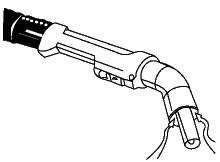Welding - Ventilation
On this page
Where can I find some general guidelines for welding ventilation?
Back to topVentilation is used for three general purposes:
- Remove air contaminants from a worker's breathing zone and work area,
- Prevent the accumulation of flammable or combustible gases or vapours; and,
- Prevent oxygen rich or oxygen deficient atmospheres.
For processes such as welding, brazing, soldering, and torch cutting, the primary purpose of ventilation is to remove air contaminants from the worker's breathing zone.
Different ventilation strategies may be needed in each case to remove air contaminants from the welder's breathing zone. General guidelines have been published in the CSA standard W117.2 Safety in welding, cutting, and allied processes, and the ANSI (American National Standards Institute) standard Z49.1 Safety in Welding and Cutting.
Whenever ventilation is used as a means of worker protection, the ventilation system should be used and maintained in accordance with acceptable procedures.
Where ventilation alone cannot adequately protect the welder, personal protective equipment (respirators) may also be used. Select the appropriate respirator according to the hazards present, any applicable legislation, and/or to the CSA standard Z94.4 Respiratory protection.
Please also see the OSH Answers on respirator selection, respirator care, and wearing a respirator.
What types of ventilation can be used to remove air contaminants from a welder's breathing zone?
Back to topVentilation strategies fall into three general categories:
- Natural Dilution Ventilation (least effective)
- Mechanical Dilution Ventilation
- Local Exhaust Ventilation (most effective)
Natural Dilution Ventilation
Dilution ventilation adds new fresh air to an area and can be accomplished by non-mechanical means such as opening windows and doors, or mechanical means such as wall and roof exhaust fans.
Weld out of the plume. Use a tight fitting welding helmet to shield you from the plume. By opening doors, windows and other openings in a building's structure, fresh air can be added to an area to decrease the concentration of an airborne contaminant and eventually remove it. This type of ventilation is generally considered the least effective because there is no direct control of how the airborne contaminants will move through the work area.

Natural dilution ventilation should not be used to ventilate confined spaces in areas that have structural features that prevent or obstruct natural airflow, or when the airborne contaminant contains a carcinogenic substance, or other substance of high toxicity. See CSA W117.2 for specific guidance.
Mechanical Dilution Ventilation
Mechanical dilution ventilation uses wall fans, roof exhaust fans, or other mechanical means to prevent airborne contaminants from entering a worker's breathing zone.
See the OSH Answers on Industrial Ventilation for more information.
Local Exhaust Ventilation
Local exhaust ventilation (LEV) is always the preferred method of removing welding fumes and gases. It exhausts or removes the toxic gases, fumes, dusts and vapours before they can mix with the room air.
A well-designed welding helmet can help reduce a welder's exposure to welding fumes by diverting the plume away from the welder's breathing zone.
What are some examples of Local Exhaust Ventilation?
Back to topDowndraft Bench
A downdraft bench has an open grid work surface. Air is drawn downward through the grid, drawing contaminants into exhaust ducting. Air speed must be great enough to prevent contaminants from accumulating and rising into the breathing zone. If workpieces are too large they may block the ventilation airflow or cause pockets of high velocity air (which could affect shielding gases).

Moveable Hood
Flexible ducting allows the capture hood to be moved where required. Provide an air velocity of at least 100 ft/min (0.5 m/s) across the welding arc. Place the hood as close as practical to the work. The optimal location for the hood is about 1 duct diameter from the arc.

Fume Extraction Welding Guns
The contaminants are removed very close to the source of generation and are drawn through a hose into the exhaust system. They can be very effective on flat and vertical surfaces or in corners and around flanges.

- Fact sheet last revised: 2017-09-12
